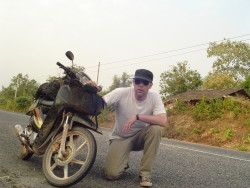
Photo. The Bike is dead, dead, dead! © Chris Tharp.
No, he said, displaying the extent of his English.
I bought a liter of oil which he poured back in. He then pushed down on the kick start with his hand to pump it through. As he did this, a full stream of oil oozed out of the engine casing. He did it again and looked closely. There was a crack in the casing. The bike had been leaking oil for a long time and I hadnt spotted it. One of the men who now gathered around mimed a rock jumping up and hitting the casing, causing the crack. The mechanic threw up his arms and told me No, once again. Evidently, I was fucked.
I looked up the empty road to the small mountains in front of me. I estimated that I had seventy or eighty kilometers until the road back to Tha Khaek. From there it was another ninety to the town. But within twenty kilometers was the town of Ban Na Hin, which was the site of another dam and gateway to a seven kilomter-long limestone cave, a popular backpacker stop. Surely this town would have a more sophisticated garage. If I could get the bike there, I could get the leak patched and still possibly make it back to Tha Khaek.
So I bought five more liters of oil, started the bike, and putted it down the road and up the mountain, blowing fat ribbons of smoke out the back like the loser of a WWII dogfight. Once the smoke cleared up I knew my oil was gone, so Id pull over and pour in another pint, praying that I had enough lube to get me to the next stop.
And I did. Soon, at the base of a large mountain, located in a lush valley, the town of Ban Na Hin appeared. I coasted down and wheeled it in the first mechanic I saw, who was a young man in his very early twenties. It took an hour for him to replace the casing, and it set me back $20, which is a small fortune in communist Laos.
Replacing the leaky engine casing
Now my oil leak was fixed, though my fear that the engine was significantly damaged was confirmed, as I rode the bike out of the town, spewing smoke and feeling the bike struggle to do its job. As I rode down the level road, I was fine. The bike sounded bad but was still going. It was only when I tried to climb the mountain out of the town that the bike bogged down and died on me once again.
So I turned the bike around and coasted it down the base of the mountain. I had not gotten very far up, but enough to where I was picking up significant speed on the way back down. And it was here that I was revisited by a previous demon: my footbrake failed yet again, only now my wounded bike was shooting straight down the foot of a mountain.
Luckily, I did not die, nor was I even hurt. I got the bike down by putting into low into gear and zigzagging back and forth along the road. This managed to slow me down enough to reasonably pop start the thing. From ther I slowly took it back into town back to my ace mechanic.
This mechanic was more enterprising than the first one who touched the brakes. He at once busted out the welder and went to work, fixing the brake problem once and for all. When I stomped down on it, it felt firm, made of titanium. I knew it would now hold.
So it was back out of town and up the mountain. This time I kept the bike in first the whole time and it did not die. It climbed up, even gaining speed. At the top of the mountain was a turnout, a scenic vista, denoted by a sign. I stopped and took in the view, which was of intricate rock formations on the surrounding mountains, at least from what I could make out. The view was marred, ruined even, by the thick haze of smoke that hung in the air. It was the dry season in Laos, the time when the farmers burn their fields. This was going on all over the country, layering the whole place under a blanket of smoke, stinging the eyes, burning the nostrils.
At this point I closed my eyes to the scenery. The surroundings became secondary to me, as all of my attention was centered on the health of the bikes engine, which was growing worse by every kilometer. I was still moving forward, going, but I felt the power weaken and the engines croak intensify. At one point I even ran out of gas, but manage to push my rapidly dying machine into a village which sold gas. By the time I made it to the road to Tha Khaek, it was barely moving. Still, I took a left and opened up my throttle all the way, which, in fourth gear, added up to what must have been no more than fifteen kilometers an hour. And it was an hour that I got on the road back to town - exactly an hour before the bike finally died, this time for good.
Dead. Dead. Dead.
The last eighty kilometers to Tha Khaek were covered in a Japanese pickup truck. I had stuck out my thumb and secured a ride from a Lao man whose name I never got. We loaded the husk of the bike into the back of his truck and rode together in silence. Even if we spoke each others language there was nothing to say. The look of defeat on my filthy sunburned face, combined with the uselessly immobile machine with me, said all that was needed.
They took the bike back at the rental agency with little hassle. The English speaking man was there in person this time no note necessary and though he looked shocked at the state of me and the machine, he handed over my passport and I handed over his keys. When I told him about the oil leak, he informed me that they had fixed it before. I guess that I unfixed it.
Back at the Travel Lodge I related my war stories to those present at the campfire. I sipped my Beer Laos bottles and described gory detail after detail, delighting in the look of amazement on their faces that I could endure such an ordeal.
Late in the night, as I wobbled from the beer, Inga and Steve rolled in, looking defeated. I had not seen them on the road that day. They had evidently taken a dirt track out of Ban Na Hin that led to the limestone cave, thirty kilometers out. They had made it only ten when Steve got a flat tire. They pushed for an hour, but found no village, no mechanic, no rice paddy saviors. Eventually, they turned back toward the town and had it fixed there, choosing to then ride back to Tha Khaek.
When I tell people about the trip, about the plague of breakdowns, most lament my awful luck. What had I done to accrue such bad trip karma? But the mechanical failings, the problems, these forced me to stop along the way in places that I would have hardly given a glance to from the road. I got to spend time in these villages and get a glimpse into real Lao life not what is packaged and sold to the Khaosan Road hordes. The problems on the trip made me relax, they made slow down. And Laos is a country best viewed in first gear.
Chris Tharp, 26 August 2007
Additional information
Presentation of the author:
Chris Tharp is a former actor, comedian, and playwright from Seattle, Washington.
He currently lives in South Korea, where he teaches at Busan Kyungsan College. He spends his spare time writing, fishing, playing music, motorcycling, performing, hiking, drinking, and eating still-moving seafood, though not necessarily in that order. Check out his blog: http://www.livejournal.com/users/tharp42





 Photo. The Bike is dead, dead, dead! © Chris Tharp.
Photo. The Bike is dead, dead, dead! © Chris Tharp. 





